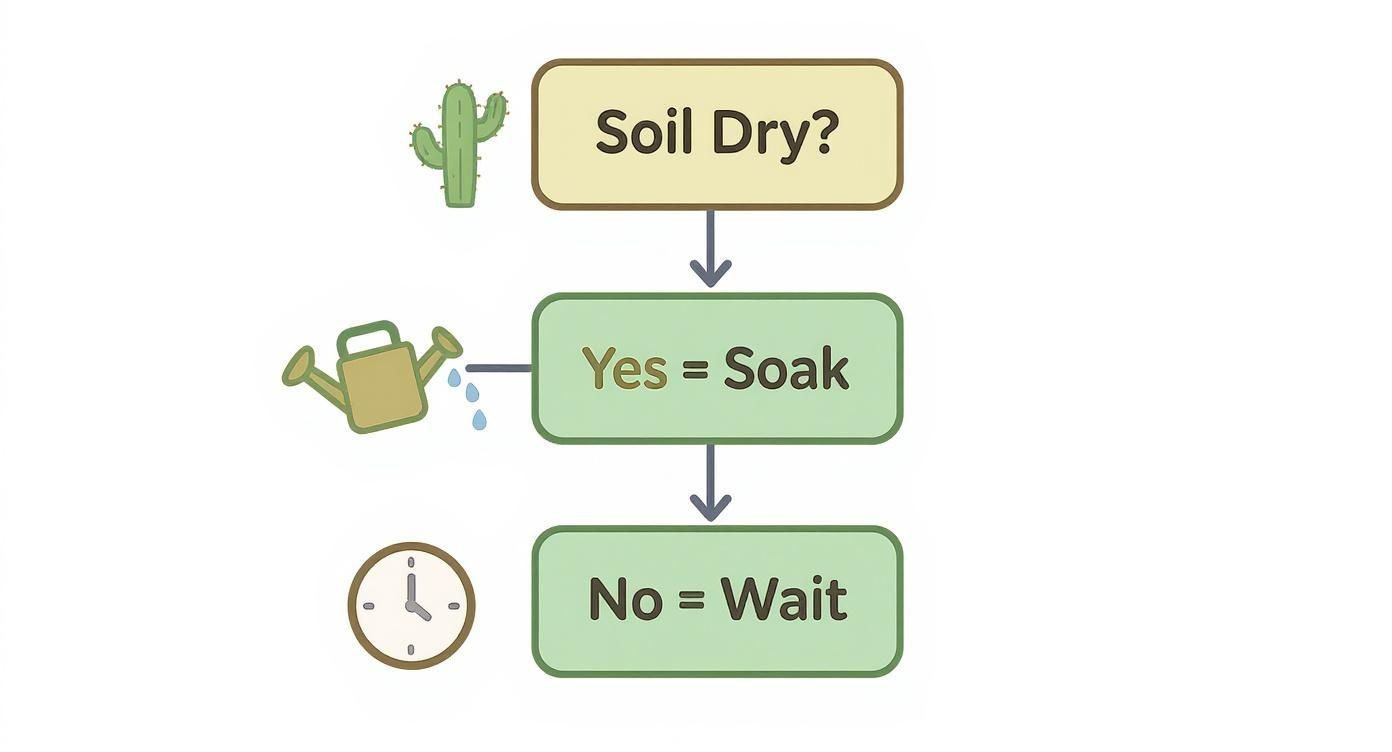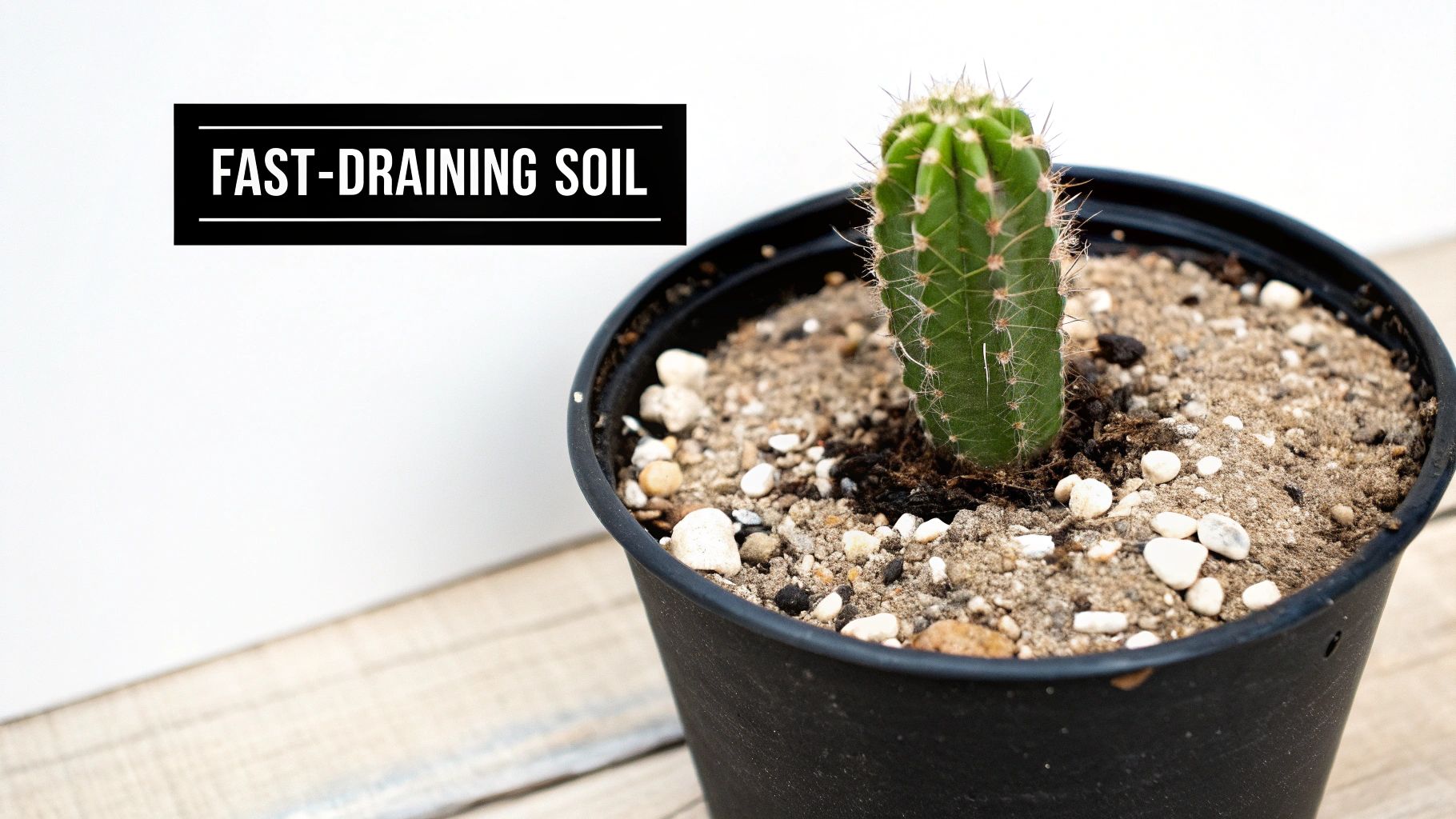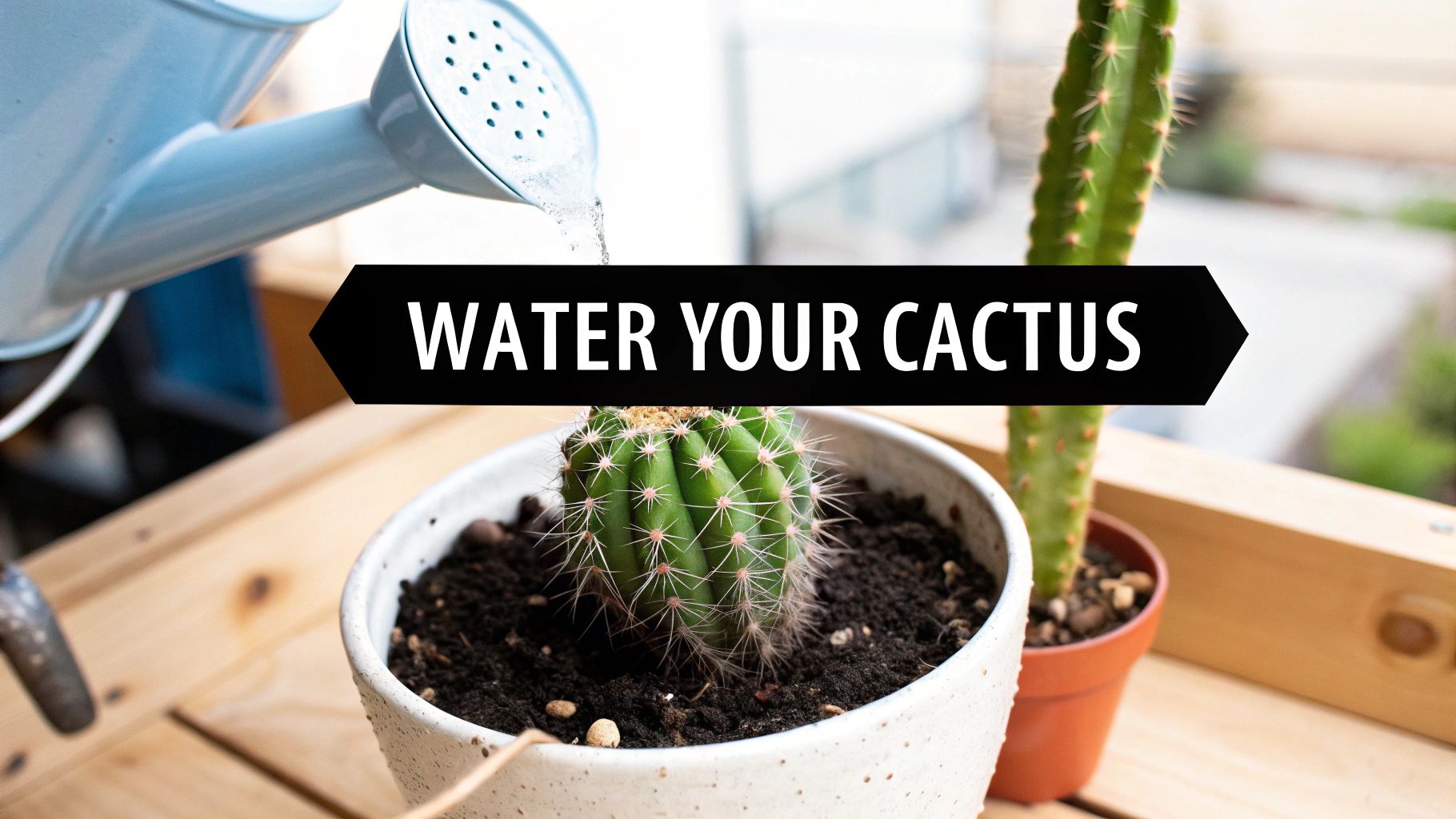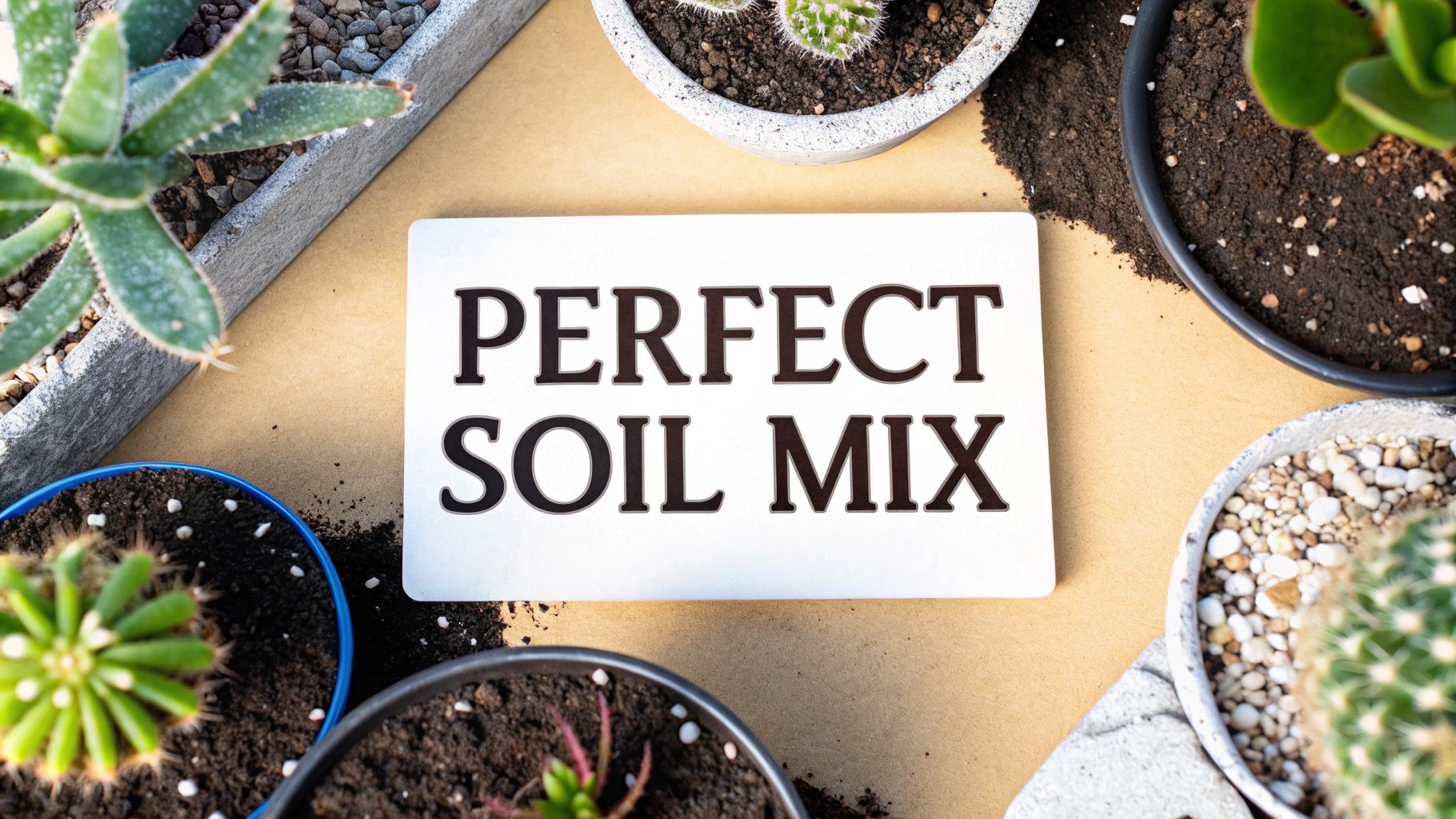If there's one golden rule for watering a cactus, it's this: soak the soil completely, then let it dry out completely. This single practice, known as the "soak and dry" method, is the absolute best way to prevent root rot—the number one killer of these tough desert survivors.
Mastering the Golden Rule of Watering Cacti
The most common mistake I see new cactus owners make is treating their plant like a fern or a pothos. Cacti are fundamentally different. They're masters of water storage, engineered by nature to thrive in places where rain is rare but heavy. Your goal is to mimic that natural cycle right in your home.
Forget about watering on a strict schedule, like every Saturday morning. Instead, shift your mindset to checking the soil. It's far better to leave a cactus in dry soil for a few extra days than to risk watering it while the soil is still damp.
Why the Soak-and-Dry Method is So Effective
This technique perfectly imitates a desert downpour. When you give the soil a thorough soaking, you encourage the roots to grow deep and strong as they seek out all that available moisture. This deep watering ensures the entire root system gets a drink, not just the top few inches.
The "dry" part of the cycle is just as important, for two key reasons:
- It prevents root rot. Cacti roots simply can't handle sitting in constant moisture. It suffocates them and creates the perfect environment for fungus to take hold.
- It provides oxygen. As the soil dries out, it allows air to circulate around the roots, which is essential for their health and ability to absorb nutrients.
The most important takeaway is simple: it is always, always better to underwater a cactus than to overwater it. They are built for drought, not dampness.
To help you get started, here's a quick summary of the core principles.
Cactus Watering Quick Reference Guide
This table breaks down the key concepts of proper cactus watering. Think of it as your cheat sheet for keeping your plants healthy and avoiding common pitfalls.
| Principle | Why It Matters | Quick Tip |
|---|---|---|
| Soak Thoroughly | Mimics a desert rainstorm, encouraging deep root growth and ensuring the entire root system gets hydrated. | Water until it flows freely from the drainage hole. |
| Dry Out Completely | Prevents root rot by allowing roots to breathe and avoiding fungal growth in perpetually damp soil. | Check the soil with a wooden skewer. If it comes out clean and dry, it's time to water. |
| Water the Soil, Not the Plant | Wetting the cactus body can lead to rot or create spots, especially in humid conditions. | Use a watering can with a narrow spout to direct water at the soil level. |
| Adjust Seasonally | Cacti need more water during their active growing season (spring/summer) and much less during winter dormancy. | Cut watering frequency by at least half in the fall and winter months. |
Understanding these principles will set you on the right path, but putting them into practice is what truly matters.
Applying the Rule in the Real World
So, what does this look like day-to-day? For most cacti, you'll likely be watering every two to four weeks during the spring and summer growing season. Horticultural studies suggest an average-sized cactus might only need about 150-250 milliliters of water per session during this time. For more insights into cactus product trends, you can explore resources like the cactus products market report on sphericalinsights.com.
Ultimately, the best approach is to learn how to "read" your plant and its environment. Factors like your pot size, the type of soil you use, how much sunlight it gets, and the humidity in your home will all affect how quickly the soil dries. Moving away from a rigid calendar and toward careful observation is the real secret to mastering how to water a cactus and keeping it thriving for years to come.
Adjusting Your Watering to the Seasons
If you want your cactus to thrive, you have to think like a cactus. They don't follow our calendars; they follow the sun and the seasons. Understanding this natural ebb and flow is the single most important part of getting your watering routine right.
During the long, warm days of spring and summer, your cactus is wide awake and ready to grow. This is its active growing season, when it's putting out new pads, arms, and maybe even flowers. This is the time to water generously, giving it a good, deep drink whenever the soil has completely dried out. A thorough soaking encourages the roots to grow deep and strong, building a solid foundation for all that new growth.
For instance, a Golden Barrel cactus basking in a sunny, south-facing window in the middle of July might be thirsty every two weeks. But that same cactus in a cooler spot with less light might only need a drink every three or four weeks. It’s all about checking the soil, not sticking to a rigid schedule.
The All-Important Winter Rest
As the days get shorter and cooler in the fall, your cactus starts winding down for a long winter nap. This dormancy period is not just a break—it's absolutely essential for the plant's long-term health. Growth grinds to a halt, its metabolism slows way down, and its need for water drops dramatically.
This is where so many people go wrong. Watering a dormant cactus on a summer schedule is the fastest way to kill it with kindness. The plant simply can't use the water, so it just sits in the cold, damp soil, creating the perfect conditions for deadly root rot. For most species, you’ll want to scale back watering to as little as once every four to six weeks, or sometimes even less.
This simple guide breaks down the core decision-making process for watering, no matter the time of year.

The key takeaway here is simple: let the soil tell you when it's time to water, not the calendar on your wall.
Seasonal Cactus Watering Adjustments
To make it even clearer, let's look at the two seasons side-by-side. Forget specific dates; instead, pay attention to the real-world changes in light, temperature, and your plant’s own behavior.
| Aspect | Spring/Summer (Growing Season) | Fall/Winter (Dormant Season) |
|---|---|---|
| Watering Frequency | Every 2-4 weeks, once soil is completely dry. | Every 4-6+ weeks, only when soil is bone-dry. |
| Watering Goal | To fuel new growth and build a strong root system. | To prevent root rot and honor the plant's rest cycle. |
| Key Indicator | Soil is dry to the touch, and you see active growth. | Soil is bone-dry, and the plant looks dormant. |
| Common Mistake | Not soaking thoroughly, leading to weak, shallow roots. | Watering too often, leaving roots to rot in cold, wet soil. |
This table neatly sums up how your strategy should shift as the year progresses.
My best advice? When in doubt during winter, just wait. A cactus can bounce back from being a little thirsty far more easily than it can recover from being drowned.
Learning to adapt to the seasons is what separates the casual plant owner from the true expert. By giving your cactus what it needs when it's actually using it—and leaving it alone when it’s resting—you’re working with its natural life cycle. This not only keeps your plant healthy but sets it up for a burst of beautiful growth when spring rolls around again.
Perfecting Your Watering Technique
Knowing when to water your cactus is only half the battle—how you do it is just as critical. The right approach gets water down to every last root, while the wrong one can cause a world of problems.
Let's walk through the two best methods I've used over the years: the classic top-down soak and the gentler bottom-up approach.
Top Watering: The Classic Soak-and-Dry
Most of us instinctively water from the top, and for good reason. It mimics a natural desert downpour and it’s incredibly effective when done right.
The goal here isn't just to get the soil damp; you want to completely drench it. Pour water evenly over the soil surface until it starts running freely from the pot's drainage holes. This deep soak encourages roots to grow downward and ensures there are no stubborn dry pockets left hiding in the pot.
I recommend using a watering can with a long, skinny spout. This gives you the control to aim directly at the soil and avoid splashing the body of the cactus, which can sometimes lead to rot or fungal spots, especially indoors. Keep pouring until you can feel the pot is noticeably heavier and water has finished draining out the bottom.
Bottom Watering: Let Your Cactus Drink Its Fill
This has become a favorite technique for many collectors, and it’s a game-changer for certain plants. Bottom watering lets the cactus soak up moisture from the base, which is fantastic for promoting strong, deep roots and keeping water off the plant itself.
It’s simple. Just find a saucer, tray, or even a sink basin and fill it with an inch or two of water. Set your cactus pot (it absolutely must have drainage holes for this to work) into the water and just let it sit.
After about 15 to 30 minutes, you'll notice the soil at the top looking damp as it wicks moisture all the way up. That’s your cue to take it out. Let the pot drain any excess water for a few minutes before putting it back in its spot. This method is perfect for those fuzzy or densely-spined cacti that are tough to water from the top.
While cacti and succulents are cousins, their care can differ slightly. For a deeper dive, check out our guide on how to properly water succulent plants.
A Quick Tip on Water Quality: What kind of water are you using? Straight-from-the-tap cold water can shock a cactus’s sensitive roots. I always let my water sit out until it reaches room temperature. If you really want to spoil your plants, use rainwater or distilled water—they’re free of the minerals and chlorine in tap water that can build up in the soil over time.
So, Top or Bottom Watering?
Honestly, there’s no single "best" way; it often comes down to the plant and your personal preference.
- Go with Top Watering if: You want a quick, no-fuss method that feels natural and helps flush out any mineral buildup from the soil.
- Try Bottom Watering if: You're worried about getting water on the cactus itself, or you really want to encourage those roots to dig deep and fill the pot.
No matter which you choose, the core principle is the same: soak the soil completely, then let it dry out completely. That’s the rhythm cacti thrive on. Don’t be afraid to experiment with both methods to see what your plants respond to best. You'll get the hang of it in no time.
The Critical Role of Soil and Drainage

You can have the most dialed-in watering schedule on the planet, but it won't mean a thing if the foundation is wrong. When you water your cactus, what happens after the water hits the soil is just as important as how much you give it. Your pot and soil are the entire support system, and getting them right is the difference between a thriving plant and a rotting one.
The single biggest killer of well-intentioned cacti is using standard, all-purpose potting soil straight from the bag. That stuff is engineered to hold onto moisture for leafy, thirsty plants—the exact opposite of what a cactus needs. Its dense, heavy structure becomes a swamp around the roots, suffocating them and leading straight to rot.
Building the Perfect Cactus Home
So, what’s the secret to a happy cactus home? It all comes down to a soil mix that's gritty, airy, and lets water pass through quickly. You achieve this by adding inorganic materials that create pockets for air to circulate and pathways for water to escape.
The best mixes rely on a few key ingredients for top-notch drainage:
- Pumice: This is a lightweight volcanic rock that won't compact over time, ensuring permanent aeration for the roots.
- Perlite: Another volcanic glass that keeps the soil light and fluffy, preventing it from turning into a brick.
- Coarse Sand: We’re not talking about fine beach sand here. Coarse horticultural sand is what you want, as it improves drainage instead of turning into concrete.
When you use a soil with these components, the cactus roots get the quick drink they need, and any excess water immediately flows away. It mimics the exact conditions they'd experience in their native desert environment. For a deeper dive, we've put together a complete guide on the best cactus and succulent soil composition.
The Non-Negotiable Drainage Hole
This leads us to the most critical feature of any pot you choose for your cactus: it must have a drainage hole. No exceptions. A pot without a hole is just a bathtub waiting to drown your plant.
What if you find the perfect decorative pot, but it has no hole? Don't plant directly in it! Either drill a hole yourself (it's easier than you think) or use it as a "cachepot." Just slip a slightly smaller pot with proper drainage inside the decorative one.
This obsession with drainage is tied directly to how cacti are built. They are master water-storers, designed to survive epic droughts. A mature saguaro, for example, can hold up to 200 gallons of water in its tissues to last through months or even years of dry spells.
By giving your cactus the right soil and a pot with drainage, you’re honoring its natural biology. You’re letting the roots breathe and ensuring the water you provide is a life-saver, not a death sentence. Getting this groundwork right is the most important step you'll take.
How to Read Your Cactus for Watering Cues

Your cactus is always talking to you, just not with words. It uses a language of subtle visual cues to tell you exactly what it needs. Once you learn to read these signs, watering stops being a guessing game and becomes a confident, responsive part of your care routine.
Instead of sticking to a rigid schedule, you just need to look at your plant to know if it's thirsty, drowning, or perfectly happy. Let's get into what to watch for.
Signs of an Overwatered Cactus
This is the number one mistake people make, and it's the most dangerous. A cactus that's getting too much water will send out some clear distress signals before it's too late.
Keep an eye out for these tell-tale signs:
- Soft or Mushy Spots: Gently feel the base of the cactus right where it meets the soil. If it feels soft, squishy, or even a bit unstable, that’s a classic sign that root rot is taking hold.
- Yellowing or Pale Color: A healthy cactus should have a rich, vibrant green color. When it starts looking washed-out, pale, or turning a sickly yellow, it's screaming stress—usually from soil that's constantly wet.
- A "Waterlogged" Look: The plant might appear swollen, almost translucent, like its cells are about to burst. In more advanced cases, you'll see black or brown patches of decay forming on the stem.
If you see these symptoms, you need to act fast. Overwatering can be fatal, but catching it early gives you a fighting chance. The first thing to do is stop watering immediately. Then, move the plant somewhere with better airflow to help that soil dry out.
Recognizing an Underwatered Cactus
While not as immediately life-threatening as too much water, a thirsty cactus will definitely let you know it needs a drink. The signs of dehydration are pretty distinct and, thankfully, much easier to fix.
Here’s what to watch for:
- Wrinkling or Shriveled Skin: The cactus will start to look a bit deflated. Its skin might pucker or wrinkle, almost like a raisin, as it taps into its internal water reserves to survive.
- Leaning or Drooping: A really dehydrated cactus might lose its upright, turgid structure and begin to lean over or droop. This is a clear indicator that its water tank is running on empty.
- Dry, Brown, or Crispy Tips: On some species, the tips or edges might start to turn brown and feel brittle or crispy when you touch them.
An underwatered cactus is almost always easier to save than an overwatered one. Its natural adaptations for drought mean it's built to bounce back from a dry spell with a proper, thorough drink.
Your Recovery Action Plan
Once you've figured out the problem, it's time to fix it. For a thirsty plant, the solution is simple: give it a good, deep watering using the soak-and-dry method. You should see it plump back up in just a few days.
Rescuing an overwatered cactus is a bit more involved. If the soil is just a little too damp, letting it dry out completely might do the trick. But if you suspect root rot has set in (that mushy base is the big clue), you'll need to do an emergency repot into fresh, dry cactus mix. For a step-by-step guide through this delicate process, check out our post on how to revive a dying cactus.
Learning to spot and respond to these cues quickly is what makes all the difference between a struggling plant and a thriving one.
Got Questions About Watering Your Cactus? We’ve Got Answers.
Even after you get the hang of the basics, some specific questions always seem to come up. It happens to everyone. Let's tackle some of the most common ones we hear from our community so you can water with total confidence.
Think of this as your go-to cheat sheet for those "am I doing this right?" moments.
How Can I Be Sure My Cactus Soil Is Actually Dry?
Don't trust your eyes on this one. The top inch of soil is a notorious liar—it almost always dries out first, while the soil down where the roots are can still be plenty damp. The best way to know for sure is to get your hands a little dirty.
The old-school finger test is still the most reliable method. Just stick your index finger about two inches deep into the soil. If you feel any coolness or moisture, hold off on watering for a few more days. It’s that simple.
But what about those big, deep pots you can't reach into? Grab a wooden dowel or an uncooked chopstick.
- Gently push it down into the soil, trying to get close to the bottom without jabbing any major roots.
- Leave it in there for a minute or two.
- Pull it out and check it. If it comes out perfectly clean and dry, it's watering time. If you see dark, damp soil clinging to it, your cactus is telling you to wait.
Here’s another trick I’ve picked up over the years: get a feel for the weight of your pot. Lift it right after you’ve given it a good, deep watering. Then, lift it again when you know for a fact it's bone-dry. Soon enough, you'll be able to tell if it’s thirsty just by picking it up.
Does the Pot I Use Really Affect Watering?
Oh, absolutely. The type of pot you choose is a huge factor in how often you'll need to water. It all comes down to how well the material breathes.
Terracotta and other unglazed clay pots are porous, which is a fancy way of saying they let air and moisture pass right through their walls. This is fantastic for cacti because it means the soil dries out much faster and the roots get great airflow. If you’re a bit heavy-handed with the watering can, terracotta is your best friend—it’s very forgiving.
Plastic or glazed ceramic pots, on the other hand, are non-porous. They trap moisture inside, so the only places water can escape are the soil surface and the drainage hole. They work just fine, but you have to be much more careful. Double-check that the soil is completely dry before even thinking about adding more water.
No matter what pot you choose, one thing is an absolute deal-breaker: it must have a drainage hole. This is the single most critical feature for preventing root rot and keeping your cactus alive. Excess water has to have a way to get out, period.
And don't forget that a tiny 2-inch pot will dry out in a flash compared to a massive 10-gallon container. Always adjust your watering routine to fit your specific plant and pot combination.
Ready to build the perfect home for your cactus? The Cactus Outlet has you covered with our specially formulated, fast-draining cactus soils and a great selection of planters. We’ve designed them to give your plant the best possible start. Check out the collection at https://www.cactusoutlet.com and give your cactus the foundation it deserves.




